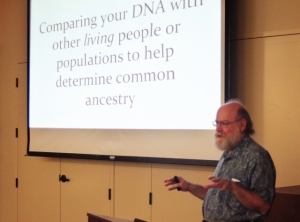Olde Dobbs offers a lesson in DNA
By Joey Pitchford
Published in News on July 17, 2016 1:45 AM

News-Argus/JOEY PITCHFORD
Genealogist David McCorkle speaks to the Olde Dobbs Genealogical Society at the Wayne County Public Library Saturday. McCorkle talked to the group about the uses of DNA testing in genealogical research, and the different options available for testing.
The Olde Dobbs Genealogical Society met at the Wayne County Public Library Saturday to learn about the applications of DNA testing in finding relatives and extending family trees.
Speaker David McCorkle, a genealogist who manages several DNA projects, gave the presentation, which focused primarily on the different methods of DNA testing and the pros and cons of using each one.
DNA, McCorkle said, can be used to find distant relatives, although the matches become more consistent and distinct the closer in time the two people are to one another. He said that DNA testing is very effective, but is limited because not everyone has submitted DNA test material to genealogy services. This has largely to do with public perception of what DNA tests are for.
"Usually when you hear the phrase 'DNA test' you're thinking either a crime scene or a paternity lawsuit," McCorkle said. DNA tests consist only of a cheek swab or a spit sample mailed into a genealogy service such as ancestry.com.
Ninety-nine percent of human DNA is completely identical. This DNA is responsible for the basic structure of the human being; how the heart beats, how many fingers per hand and all the other physical characteristics shared between all humans. The last .1 percent is what accounts for all of the things that make us unique as individuals, from skin and hair color to blood type, gender, eye color and more. This is the section that genealogy is concerned with, McCorkle said, because it is where differences and similarities between people are identified. Genealogists can use these to determine to what degree, if any, a person is related to another.
The three types of DNA testing McCorkle spoke about were autosomal testing, Y chromosome testing and mitochondrial testing. Each offers different advantages and disadvantages, generally related to how far back and how broadly a genealogist wants to search.
Autosomal testing offers the broadest selection of potential matches, as it compares the entire DNA sample to other entire samples and looks for any matches between them. Because autosomal testing is relatively simple, anyone can make use of it. However, McCorkle said that the process is an inexact science. As one looks at older and older generations, they risk being matched with someone with whom they share only a fraction their DNA-a false positive.
The other two types of testing, Y chromosome and mitochondrial, are dependent on gender. As only men have the Y-chromosome, they are the only ones capable of using the Y-chromosome test, and it tracks ancestry only through the men in the family. Similarly, because a mother passes mitochondrial DNA (mtDNA) to her children unchanged, it can be used to track a person's matrilineal ancestry.
McCorkle suggested that those looking for autosomal DNA testing go through ancestry.com, because of its database of around 2 million people. He said 23andme.com would be a good place to go for mtDNA tests, while Family Tree DNA is the go-to for Y-DNA testing.
